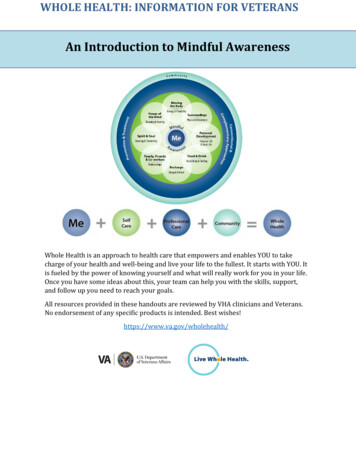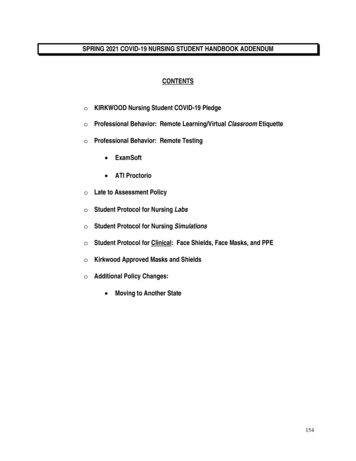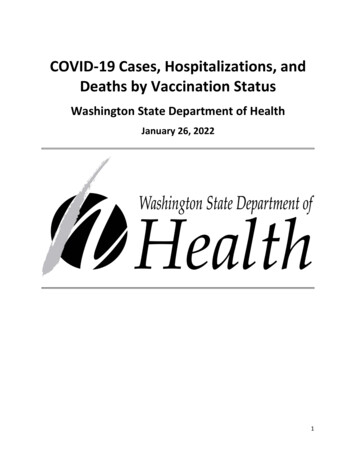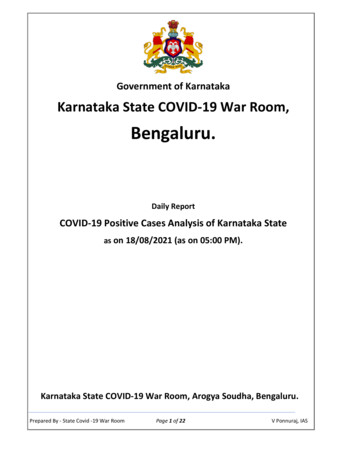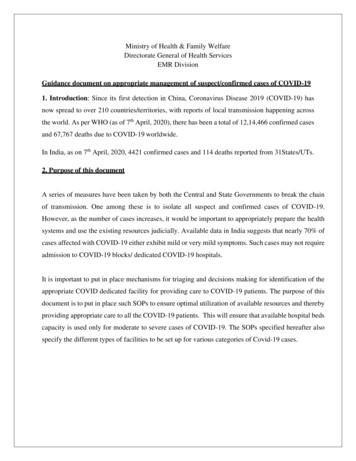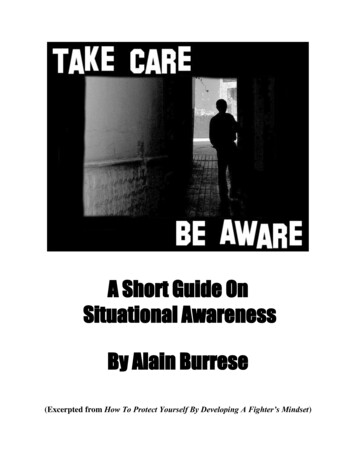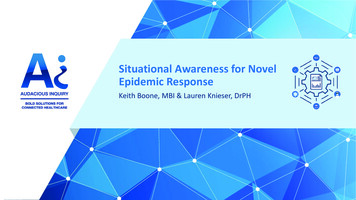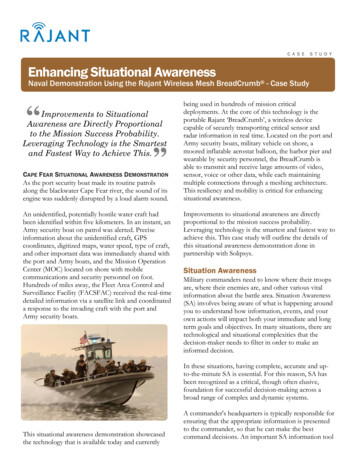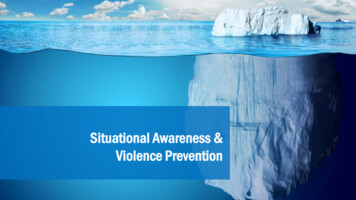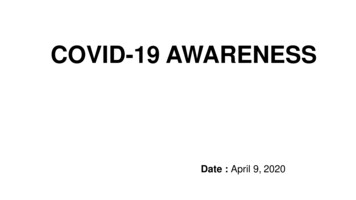
Transcription
COVID-19 AWARENESSDate : April 9, 2020
DisclaimerThe information provided in this training is based on currentinformation regarding best practices obtained fromguidance and publications issued by the U.S. Centers forDisease Control and Prevention as well as other federal,state and local public health officials, as of the date of thistraining.Date of training: April 9, 2020
Training purposeThis training is designed to: Raise safety awareness about COVID-19.Provide the latest safety guidance.Provide instructions on how to correctlywear personal protective equipment—PPE.Image: CDC
Important notesAny illnesses, including COVID-19positive cases, in the workplaceput others at risk.If you are sick, please stayhome!Practice social distancingmeasures at all times.Image: CDC
Coronavirus and COVID-19Coronavirus disease 2019, or COVID-19, is arespiratory illness spreading from person-to-person.COVID-19 is considered a global pandemic withcommunity spread.Symptoms may include fever, muscle or bodyaches, sore throat and cough, fatigue andheadaches.Image: CDC
Reducing community spread of COVID-19Take steps to protect yourselves and others: COVID-19 is spread person-to-person or by touchingcontaminated surfaces. No vaccine is currently available. Asymptomatic individuals can spread the disease. Avoid being exposed to prevent illness.Image: CDCStay 6 feet apart.
Cloth face covers
Cloth face coversCloth face covers can help preventpre-symptomatic andasymptomatic individuals frominadvertently spreading the virus toothers.Wear cloth face covers in public whensocial distancing is difficult tomaintain.Image: CDC
Fabric comparisonsConsider breathability versus filtration.More suitable: Pillowcase, bed sheets or100% cotton t-shirt.Less suitable: Vacuum bag and teatowel—not breathable; silk—toobreathable.Image: Karen Albrecht
Fabric comparisonsThe CDC recommends two layers oftightly woven 100 percent cottonfabric, such as quilter’s material orbedsheets with a high thread count.Image: Washington Post
Information about face cloth coversCloth face covers should go over themouth and nose.Cloth face covers are meant to protectothers in case you are infected.Image: CDCThe cloth face cover is not asubstitute for social distancing.
Cloth face covers should Fit snugly but comfortably against face.Be secured with ties or ear loops.Include multiple layers of fabric.Allow for breathing without restriction.Be able to be laundered and machine dried.Image: CDC
Cloth face coversCloth face covers can be made at home as avoluntary public health measure.Should not be worn by: Children under 2.Anyone who has trouble breathing.Anyone who is unconscious, incapacitated orunable to remove the cloth face cover withoutassistance.Image: CDC
Cleaning instructions for cloth face coversCloth face coverings should be routinelywashed in a washing machine.Do not to touch eyes, nose, or mouth whenremoving cloth face covers.Wash hands with soap and water or applyhand sanitizer after removing cloth facecovers.Image: CDC
Sewing instructions for cloth face coversMaterials Two 10”x6” rectangles of cotton fabricTwo 6” pieces of elastic or rubber bands, string,cloth strips, or hair ties. Needle and thread or bobby pin.Scissors.Sewing machine.Image: CDC
Sewing instructions for cloth face covers1. Cut out two 10-by-6-inch rectangles ofcotton fabric. Use tightly wovencotton, such as quilting fabric orcotton sheets. T-shirt fabric will workin a pinch. Stack the two rectangles;you will sew the face cover as if it wasa single piece of fabric.Image: CDC
Sewing instructions for cloth face covers2. Fold over the long sides ¼ inchand hem. Then fold the doublelayer of fabric over ½ inch alongthe short sides and stitch down.Image: CDC
Sewing instructions for cloth face covers3. Run a 6-inch length of 1/8-inch wideelastic through the wider hem on eachside of the face cover. These will be theear loops. Use a large needle or a bobbypin to thread it through. Tie the endstight. Don’t have elastic? Use hair tiesor elastic head bands. If you only havestring, you can make the ties longer andtie the face cover behind your head.Image: CDC
Sewing instructions for cloth face covers4. Gently pull on the elastic so that theknots are tucked inside the hem.Gather the sides of the face cover onthe elastic and adjust so the mask fitsyour face. Then securely stitch theelastic in place to keep it from slipping.Image: CDC
Quick cut T-shirt cover—no sew methodMaterials: T-shirt and scissorsImage: CDCImage: CDC
Bandana face cover—no sew methodMaterials: Bandana—or square cotton cloth approximately 20”x20”, coffeefilter, rubber bands or hair ties and scissors if you are cutting your owncloth.Image: CDC
Bandana face cover—no sew methodImage: CDC
Cloth face coversFor tutorials about how to make cloth face covers, please visit the mlImage: CDC
Dr. Jerome Adams, Surgeon Generalhttps://www.youtube.com/watch?v tPx1yqvJgf4&feature youtu.be
Safety precautions andprocedures
Safety precautions and proceduresECSU personnel working on-site should follow safety precautions andpractice recommended procedures to minimize the spread of COVID-19.Participate in health screening protocols, when checking in with yoursupervisor, if applicable.
Health screening questions1. Are you sick or do you feel ill?2. Do you have a fever?3. Have you experienced any new respiratory symptoms, such as acough or shortness of breath, within the last 14 days?4. Have you had close contact with anyone who has tested positive forCOVID-19, or who has been tested and is waiting for results whilethey had symptoms or in the two weeks before they began showingsymptoms?5. Have you traveled outside of Connecticut in the past 14 days?
Social distancingAvoid crowded places.Maintain a distance of at least sixfeet— two meters—from others.Stay outside or come back at a latertime if a building is too crowded.
SOCIAL DISTANCING IN ELEVATORSCOVID-19 ELEVATOR SAFETY HELP REDUCE THE SPREAD OF COVID-19 LIMIT ONE PERSON PER ELEVATOR RIDE
Good respiratory hygieneCover mouth and nose with tissues whencoughing or sneezing or use the inside of elbow.Throw away used tissues in the trash. Do notleave on top of surfaces.Wash hands with soap and water or apply handsanitizer.
Good hand hygieneAvoid touching eyes, nose andmouth with unwashed hands. If soap and water are notavailable, use a hand sanitizerthat contains at least 60 percentalcohol. Cover all surfaces ofhands and rub together until dry.
Voluntary use of PPE
Voluntary use of PPEAccording to the CDC and the WorldHealth Organization, the use ofPPE in public areas is voluntary.
Donning and doffing PPE
Donning and doffing of PPEDonning and doffing is the practice ofputting on and removing personal protectiveequipment.Donning refers to putting on personalprotective equipment.Doffing refers to removing personalprotective equipment.Image: CDC
Donning a surgical mask1. Wash hands with soap and water or apply handsanitizer before donning a mask.2. Place mask on face with ear loops over ears.3. The mask should cover your nose and mouth withno gaps between the mask and your face.4. Wash hands with soap and water or apply handsanitizer.5. Avoid touching the mask while wearing it.
Doffing a surgical mask1. Wash hands with soap and water or apply hand sanitizer.2. Use the ear loops to remove the mask avoiding touching the front ofthe mask or your face.3. If the mask is in good condition and not soiled, you may reuse it.4. Carefully place the mask into a clean Ziploc bag, labeled with theuser’s name. Avoid compressing the mask. Do not seal the bag.5. Wash hands with soap and water or apply hand sanitizer.Note: If the mask was worn during an encounter with another person whodisplayed obvious signs of illness, discard of the mask in the trash.
Reusing a surgical maskIf using a surgical mask and following social distancing practices,the likelihood of the mask being contaminated is very low.1. Wash hands with soap and water or apply hand sanitizer.2. Remove mask by holding the ear loops.3. After removing facemask, visually inspect for contamination, distortionin shape or form. Discard in trash if soiled, torn, or saturated.4. Carefully store in an unsealed bag labeled with your name on it.5. Wash hands with soap and water or apply hand sanitizer.
Procedures for donning gloves1. Wash hands with soap and water or applyhand sanitizer before donning gloves.2. Select properly sized gloves.3. Don one glove per hand.4. Inspect gloves for any tears or holes andreplace gloves if any defects are detected.
Procedures for doffing gloves1. Grasp the outside edge near your wrist.2. Peel away from your hand, turning the glove insideout.3. Hold in opposite gloved hand.4. Slide ungloved finger under the wrist of the remainingglove.5. Peel off from inside, creating a bag for both gloves.6. Discard gloves in the garbage.Image: CDC
Demonstration of gloves donningand doffing posable-gloves-video
CLICK ON THIS LINK TO TAKE THEONLINE px?id Q5WDlOVlRWUzhZTU41S1FZUlc1Ry4u
CREDITASU Safety ://www.cdc.gov/WHOhttps://www.who.int/
Sewing machine. Image:CDC. Sewing instructions for cloth face covers. Image:CDC. 1. Cut out two 10-by-6-inch rectangles of cotton fabric. Use tightly woven cotton, such as quilting fabric or cotton sheets. T -shi



